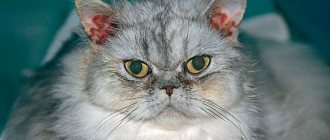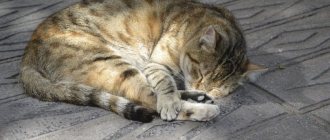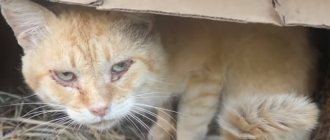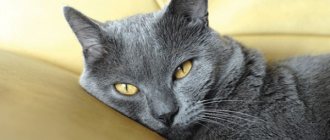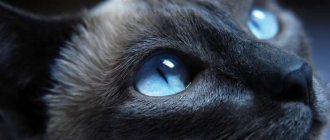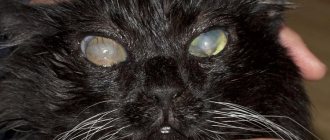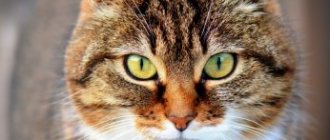Natural work
If the animal is healthy, the secretion is released freely during self-defense, marking the area and during defecation. Unfortunately, human care and the emergence of a large number of decorative breeds have led to the fact that some individuals have difficulty emptying their anal sacs on their own. This is why inflammation of the paraanal glands occurs in dogs and cats.
Who is susceptible to the disease
Most often, the pathology is observed in young males, but it is not uncommon for cats to suffer from this problem. Inflammation is especially common among long-haired animals.
In addition, the following animals are at risk:
- leading a sedentary lifestyle;
- pregnant cats;
- injured in the anus;
- those who eat poorly and are prone to diarrhea or constipation;
- with obesity.
Inflammation of the paraanal glands in a cat has a very simple mechanism of development.
First of all, the natural outflow of secretions is disrupted, as a result of which the sinuses become overfilled. After this, the liquid in the sacs becomes thick, which leads to itching - the inflammatory process begins. Irritation accelerates the growth of microflora. The affected area increases, an abscess forms and the wall of the gland breaks through. By this time, the cat's condition becomes unsatisfactory, and the temperature may rise significantly.
A disease that has reached this stage can even kill the animal. Treatment must be started as quickly as possible. In addition, it is important to remember that purulent inflammation of the paraanal glands in a cat is almost impossible to treat, and therefore becomes chronic.
The sacs, filled with fluid, increase in size and become inflamed. Sometimes this leads to the development of an abscess - purulent inflammation with ulcers and fistulas.
Enlarged glands do not allow the animal to defecate freely, sometimes reaching such volumes that it has difficulty walking.
Inflammation of the paraanal glands in a cat can be detected if you carefully monitor your pet’s behavior: she often licks under her tail, as if gnawing out parasites there, and fidgets on the floor with her butt, trying to squeeze out the secretion. After a while, the animal smells so strongly that just being near it becomes very difficult.
But that’s not all that clogged cat’s paraanal glands lead to. Symptoms of inflammation may be as follows:
- Heat.
- Severe deterioration in health.
- Refusal to eat.
Lack of treatment leads to death from blood poisoning. Bringing a sick animal to this stage is the height of irresponsibility!
Inflammation of the paraanal glands in a cat can be eliminated quite simply, although this procedure is unpleasant for owners. Its essence is to squeeze out the accumulated liquid. If this procedure causes pain to the animal, it is necessary to conduct a seven-day course of antibiotic injections with Novocaine.
In difficult cases, you have to use the services of specialists - if necessary, wash the bags with special solutions. If it comes to an abscess, it must be opened, cleaned and the purulent wound treated.
If inflammation of the paraanal glands in cats, the causes of which were mentioned above, has become chronic, and the bags have to be emptied manually too often, a specialist may suggest simply removing them. These organs do not carry a significant functional load, so their absence will not affect the life and well-being of the pet in any way.
Of course, this decision should only be made by an experienced specialist.
Symptoms of anal gland blockage
In the initial stage, the cat begins to frequently lick under its tail, becomes restless, rides on its butt on carpets and other rough surfaces, and an unpleasant odor appears from the animal.
As the condition worsens, inflammation of the glands develops, which manifests itself:
- Enlarged sinuses and their pain.
- Decreased appetite.
- Lethargy of the animal.
- The development of purulent abscesses with increased body temperature and general intoxication.
What diseases have a similar clinical picture?
The symptom of licking the anus and riding the butt is also characteristic of:
- Worm infestation.
- Allergic reaction.
- Psycho-neurological disorders of the animal.
- Stress.
Self-cleansing
If you can’t get to a doctor, you can cleanse the glands at home.
Before you begin, you should put on old clothes or a protective robe. Glasses will also come in handy. It is better to carry out cleansing in the bathroom, since during manipulations an unpleasant-smelling liquid can splash in all directions.
An assistant is needed who can secure the animal with a diaper or towel. The pet must be wrapped in fabric so that only the tail remains outside.
Then you need to squeeze the anus with your thumb and forefinger, helping with a napkin. Of course, you should wear gloves on your hands. Press on the glands located at 5 and 8 o'clock from the anus until the fluid comes out.
After cleaning, administer an anti-inflammatory suppository rectally. If necessary, cleaning is repeated after a certain period of time.
The above method is only suitable when the glands are not very enlarged. If the secretion has already thickened, you have to use a more complex and painful cleansing option.
It is necessary to wear protective clothing, gloves, and secure the pet. After this, lubricate your finger with Vaseline and insert it into the anus. From the inside, feel the nodules on the sides of the anus. Squeeze each of them alternately with your fingers. Squeeze out the secretion until the gland is empty.
Of course, not every owner is ready for such feats. That is why inflammation of the paraanal glands in cats, a photo of which will add to the determination to treat the animal, can be tried to be eliminated in another way. It is worth remembering that it can only be effective in the initial stages of the disease.
To do this, you need to lubricate the anus and nearby tissues with an ointment containing an anti-inflammatory agent (for example, Syntomycin). Be sure to put a collar on the animal to prevent it from licking the medicine. Put a candle with ichthyol at night. To prevent the animal from running straight to the toilet, it is necessary to hold the anus for a while, fixing the candle.
Washing
This procedure can only be performed by a specialist. It is indicated for significant inflammation, when there is suppuration and a through hole is formed.
It is important to know that treatment at this stage will take a long time, and recovery is not guaranteed. You will have to resort to the procedure constantly in order to at least slightly reduce the animal’s pain.
Washing consists of the following steps:
- preparing and filling an antiseptic solution into a syringe;
- pouring liquid into the hole;
- repeat the procedure until the clearest liquid flows out;
- treatment with an antimicrobial agent.
To prevent the cat from licking itself, a collar, diaper or blanket is put on it.
Warning
It is worth remembering that you need to be very careful when cleaning your cat’s anal glands at home. Treatment of inflammation can also be carried out in veterinary clinics, especially if there is no experience or desire to do this. Problems can await not only squeamish owners - the process itself often causes difficulties:
- under the influence of fear and pain, the animal can seriously injure the owner, who did not secure it firmly enough;
- There are many vessels and nerve endings intertwined around the anus; inept actions can injure them, which will lead to a deterioration in the pet’s health.
If you still need to carry out the procedure yourself, you should first learn from a specialist, ask questions, clarify the technique and procedure.
The frequency of cleaning is individual in each case. For some animals, it is enough to do this once, while others have to cleanse the glands regularly.
It is very important to pay attention to your pet's behavioral habits. If there is increased attention to the back of the body, it is worth checking it for symptoms of inflammation of the glands. On average, sick animals need to clean their anal sacs once every six months, while healthy animals cope with this on their own.
Prevention
Prevention of the disease is very simple and does not require material costs:
- Regularly check the condition of the animal's anus.
- monitor your pet’s activity: the couch potato should be forced to run at least twice a day.
- monitor nutrition and gastrointestinal function, avoiding constipation.
- feed the animal in moderation, not allowing it to gain excess weight.
Just like people, cats often become victims of various diseases. Therefore, if your cat has anal discharge or any other suspicious symptoms, you should attach great importance to this.
The important thing here is to take action in time and seek the help of specialists. Only a doctor can accurately determine the cause of the discharge, identify the disease and give recommendations for treatment.
Symptoms of diarrhea in kittens
global $ads_google; //data-ad-slot=”2475549904″ $ads_google = empty($ads_google) ? false : true; ?> if ($ads_google == false) {?>
$ads_google = true; ?> } ?>
It is not difficult to determine that a kitten has diarrhea. This is necessary in order to take health measures in a timely manner and prevent serious consequences for the life of the young cat.
So, we determine loose stools in kittens:
- the kitten’s state can easily be considered depressed;
- there are problems with appetite, more often it simply doesn’t exist;
- if diarrhea is prolonged, the animal’s weight will decrease;
- frequent bowel movements;
- dehydration (when taken by the scruff of the neck, the skin then straightens out for a long time);
- loose stools, possible admixtures of undigested food;
- your tummy may be bloated.
In general, it is clear from the baby that he is experiencing discomfort, so it is important to find out what could cause such a disruption of the gastrointestinal tract.
Causes of discharge from the anus
Discharge in a cat during diarrhea or constipation is quite normal and quite common. They manifest themselves in different ways, but are fairly easy to identify, so they are not too dangerous. The owner may also notice a small amount of blood clots in them. This symptom disappears completely with complete recovery. Therefore, you should not worry too much about this.
But if the discharge from either the anus in a cat or the vaginal area in a cat is purulent or mucous in nature and has a characteristic odor, we can talk about the presence of an infection.
Often this can be associated with problems with the genital organs of cats. But there are other options that require careful testing, special tests and smears. Here you should seek the help of a specialist as soon as possible so as not to aggravate the situation and alleviate the cat’s suffering.
Often the cause of discharge from the anus is inflammation of the paraanal glands. Previously, many were inclined to think that such problems were directly related to the abundant use of dry food in the diet of pets. However, it turned out that this is a myth. Often, discharge appears due to the unusual structure of the intestine itself . For example, you may notice frequent attempts by the animal to sit on its hind legs or walk along the floor. Such manifestations of attempts to get rid of excess secretions should be immediately noticeable to the owner.
Essence and purpose
Through the anal sacs, the pet produces a special fluid (secret). Its necessity lies in the self-defense of cats and kittens from various dangers. The discharge has an unpleasant, pungent odor that even hurts a person’s nose. With the help of the secretion secreted by the paraanal glands, it is possible to throw the enemy off the scent and there is an opportunity to hide in a safe shelter. There are other functions of a similar feline structure, according to the Textbook of Veterinary Anatomy, edited by Dyce KM:
- Determining the boundaries of your own territory.
- Ensuring a painless bowel movement process. During defecation, the anal sphincters compress the fluid-filled paraanal glands and a small amount of secretion is released. This mechanism makes it easier for solid stool to pass out.
- Often the male sprays the contents of the anus to attract the attention of the female. Cats can do the same thing.
Treatment of anal discharge
But many pet owners do not want to resort to the services of veterinary clinics. Of course, if the owner is absolutely confident in his abilities and is fully aware of the situation that is happening to his cat, more independent treatment is allowed. However, beginners should listen to the opinion of doctors so as not to put their cat at risk.
Sometimes ridding a cat of discharge from the anus is not so easy . If the abundance of secretion does not decrease and lasts for several days, an examination should be performed. Here you must thoroughly wash and disinfect your hands. Next, you need to squeeze the area adjacent to the animal’s sphincter with two fingers. If at the same time a thick and viscous secretion occurs, it makes sense to think about the presence of certain disorders in the animal’s body.
To avoid worsening the situation, a whole range of measures should be taken to help correct the cat’s condition. Initially, you should arm yourself with special medical gloves. After smearing your finger with Vaseline, you need to insert it into the source of the cat’s discharge.
Carrying out manipulations according to the instructions will lead to an improvement in the pet’s condition within 2-3 days.
However, this procedure cannot be performed without special skills and a full understanding of what is happening. The best thing is to trust the professionals at the veterinary clinic, who will professionally take care of the animal’s health.
If the disease is advanced, doctors can prescribe complex treatment for the discharge. Both procedures and medications will be used here. Antibiotics are especially often recommended. If a cat is bleeding from the anus, this may be a reason for surgery . However, this is an extreme measure that is carried out quite rarely. Often less radical methods of treatment are sufficient, even if it involves bleeding.
After the cat’s condition improves, you should consult a doctor about preventing discharge. This will avoid relapses and improve the cat’s overall condition. Only compliance with the doctor's instructions can prevent the worsening of chronic diseases and the recurrence of inflammatory processes. He can give advice related to:
- cat care;
- food;
- routine examinations of the animal.
It's a shame when your beloved pet gets sick. Especially when the kitten has discharge from his butt. However, the main goal, in this case, should be a directed and productive fight against the disease.
Timely measures can not only alleviate the cat’s condition, but also quickly save it from a dangerous disease.
Therefore, most owners try to make every effort to create favorable conditions for their beloved animal to recover.
- home
- >
- Cats
- >
- Cat health
- >
- The cat has discharge from the anus: advice from a veterinarian
Treating cat bad breath
You should not listen carefully to the words of your cat-loving neighbor, who cured his purring dog’s mouth stench in some way. The causes of the problem can be completely different, so the first thing you should do is visit a veterinarian: after the appointment, it will be clear on what principle to treat the disease.
If the trouble was caused by an incorrect menu, then the first thing you need to do is balance your diet. The doctor will prescribe medications that will help eliminate the cause.
Problems with metabolism will be revealed by a blood, urine and stool test, as well as a swab of the oral mucosa. An additional symptom will be diarrhea in the cat or rare bowel movements. The diet will require the exclusion of economy-class feed and food from the host’s table.
If diabetes is suspected, it will require lifelong therapy and veterinary supervision.
If problems with internal organs or chronic diseases are indicated, an ultrasound scan or x-ray is taken.
Sometimes it is difficult to independently assess the condition of the oral cavity, so the cat is shown to a specialist: if periodontitis, tumors, caries, or excessively grown tartar are detected, qualified treatment methods will be taken.
The cat has discharge from the anus: advice from a veterinarian
Any pet can be exposed to various diseases that are complex in nature. Therefore, when a cat experiences discharge from the anus, many people think about the most effective treatment option. It is immediately worth noting that in a cat, discharge from the anus can occur for various reasons, after accurate identification of which effective treatment becomes possible.
Discharge in a cat during diarrhea or constipation is normal. Often they also contain minor traces of blood. As a rule, after the disappearance of the corresponding painful condition, such manifestations immediately disappear. In the case when a cat has purulent discharge from the anus, we can talk about the existence, as well as the subsequent development of a certain infectious disease. Moreover, it can have either a completely independent character or be a derivative of a different type of disease. For example, it is a very common situation that this is a consequence of problems with the reproductive organs in cats. In order not to self-medicate and thus not expose the animal to long-term suffering, it is best to immediately seek help from a veterinarian.
There is often a situation in which discharge from a cat’s anus occurs as a result of inflammation of the paraanal glands. For a long period of time, it was believed that the main cause was overuse of dry food. In fact, this is far from the case. Sometimes frequent manifestations of this type of disease are due to the specific structure of the intestine. One of the indisputable signs that we are talking about just such a situation can be considered the constant desire of the animal to sit on its hind legs and begin to actively move the anus area along the floor. This behavior demonstrates the desire by all possible means to free oneself from excessively accumulated secretion in the anal gland.
Many veterinarians focus on malfunctions in the functioning of the paraanal glands as one of the most common problems causing discharge. It is possible to cope with such an unpleasant manifestation on your own.
If your cat's discharge does not decrease, but does not increase, for several days in a row, you should consider the need for a home examination. In this case, initially the hands are washed well and lubricated with alcohol. Next, using your thumb and index finger, it is important to squeeze as tightly as possible the places located as close as possible to the animal’s anus. If, after correctly performed manipulations, a thick and viscous secretion occurs, then there is indeed a disruption in the functioning of the paraanal glands.
In order to prevent the possibility of the disease progressing to a more serious stage, it is necessary to take a number of additional actions. Wearing medical gloves, apply a small amount of Vaseline on your index finger and insert it into the cat's anus. Thanks to this, it becomes possible to alternately compress each of the glands located between the index finger located in the anus and the thumb located on the outside of the anus. Proper manipulation makes it possible to observe how in a couple of days the animal’s condition will return to normal levels.
If the disease has been prolonged, then you should be prepared for the active formation of fistulas, which can only be gotten rid of through comprehensive treatment (including the use of antibiotics). In more rare cases, when drug therapy has not brought the desired effect, surgery is used. True, such measures can be considered the most rarely used.
In order to subsequently reduce the risk of developing such an unpleasant disease, it is extremely important to pay attention to the animal’s nutritional habits. You should also not ignore the possibility of having your pet examined annually by a veterinarian.
It is quite possible to rid your cat of discharge from the anus. The most important thing is to initially clearly determine the cause of the disease and only then move on to measures aimed at combating it. In no case should you forget about preventive measures.
Hygiene rules for cats
To prevent the appearance of an unpleasant odor, you need to follow the rules of hygiene for cats. First of all, keep the tray clean. If a cat has to go to the toilet in wet sand, the fur may develop an unpleasant odor.
Note! If your cat's fur does not look healthy, has lost its shine, sticks together or falls out, consider this a symptom and contact your veterinarian. If a cat doesn’t wash its fur, it means it’s feeling very bad.
Clean, wash and change the covers on your cat's bed regularly. It is important to remember that a pet is in a constant state of stress if it is unable to maintain its fur at full frequency. Dirty bedding can cause your cat to refuse to rest in its place.
Cats should only be bathed when absolutely necessary. Healthy cats don't need bathing! The exception is animals that regularly participate in exhibitions. To be presented in the best possible light, the six cats are styled with special cosmetics that must be washed off after the show.
Important! Never cut your cat's hair, even if it seems to you that she is very hot! The only valid reason for grooming a cat is veterinary indications - extensive skin lesions, tangles that cannot be eliminated, etc.
Discharge in a dog
Usually this problem in bitches is accompanied by other signs of deterioration in health. You need to pay attention to them and act without delay. As a rule, only a good, qualified veterinarian can accurately determine the cause of the discharge. The owner himself cannot do this. The doctor will prescribe treatment for the dog after an accurate diagnosis.
When a bitch's discharge is purulent
Venereal sarcoma, hemometra, pyometra are their possible causes. In this case, green or brownish mucus is released from the bitch's loop. The exudate may be a mixture of blood and pus. If the dog is old, then the cause of the pathology is pyometra. This is what veterinarians call acute inflammation of the female uterus. The disease occurs in those bitches for whom chemical contraceptives are often used, in other words, pills. Their use should be dosed and only with the permission of a doctor. And uncontrolled use can precisely cause inflammation of the uterus and the release of purulent mucus. Pyometra occurs mainly in bitches older than 6 years who have not had offspring. The disease is characterized by intoxication of the entire body, that is, the dog becomes stunted, its thirst increases, and a putrid smell is heard from the mouth. If your pet lives in an apartment, it’s hard not to notice the characteristic brownish-dirty spots on the floor. They smell terrible.
Treatment of the disease is carried out surgically - the bitch's uterus is removed along with the appendages. Before the operation, intravenous medications are administered so that the patient can tolerate it more easily and recover faster. After the procedure, a course of antibiotics is required. If you notice purulent discharge from your pet, rush to the doctor. After all, a dog can die from intoxication.
Endometritis is another cause of green and brownish discharge in a bitch. The disease occurs in acute or chronic form
Source
The cat is bleeding from the anus
The article provides answers to questions that are associated with such a serious problem and thanks to which you can provide real support to your pet, but it is worth remembering that only contacting a veterinarian will guarantee a positive result.
There may be several reasons for the occurrence of blood from the anus. For example, a constipated cat will strain a lot, which may cause a small amount of blood to come out, but this is not normal if the bleeding is constant.
If the bleeding is profuse, then it may be problems with the rectum; colitis and other similar diseases complicate the process of bowel movements. Worms can cause bleeding due to destruction of the intestinal walls.
If a cat bleeds from the urethra after sterilization, this indicates that the operation was performed poorly. The right option would be to go to another clinic for an examination and tests.
- If two tablespoons of red blood comes out, then the cat needs cupping, otherwise it will die. The cause may be rupture of uterine tissue;
If a cat has bleeding from the urethra after mating, she needs to have an ultrasound + blood biochemistry + urine test + swab from the loop for infection.
— Urea – the norm is 2-8 mmol/l, a deviation from the norm indicates an unstable content of the enzyme, which disrupts the functioning of the kidneys, liver, and gastrointestinal tract;
— Direct bilirubin – 0-5.5 µmol/l, an increased value of this enzyme shortens the cat’s life and indicates a violation of the liver;
— Creatinine – the norm is 40-130 mmol/l; if the creatinine level is higher than normal, then the kidneys are the first to suffer, which leads to urolithiasis.
If your cat is vomiting blood, contact your veterinarian immediately. The doctor will need to tell you why the vomiting started, as often happens. You can't call it yourself
Source
In the modern world, quite often people are faced with such a problem as discharge from the anus. This symptom always causes discomfort and is alarming. Quite often a late visit to the doctor occurs due to a feeling of awkwardness. The symptom can manifest itself in different ways: discharge is noted as an independent phenomenon, occurs during bowel movements, or can be in the form of an admixture in the stool. They can be mucous, purulent, bloody or mixed. But such a symptom can indicate a number of serious diseases, so it is recommended not to delay a visit to the proctologist.
Possible causes of anal discharge
Discharge in the form of mucus and pus is more common than discharge of blood from the anus. Most often, discharge is detected during the process of defecation, although it can also be released regardless of the process of emptying. The reasons that influence the appearance of discharge from the anus can be quite varied. Among them are:
As a result, due to the large amount of moisture, the skin wrinkles, and deep and painful cracks can form in the anus. When mucus gets on the cracks, it causes irritation and the patient experiences a feeling of burning, itching, and tingling.
Discharge from the anus may be mixed with pus or blood, accompanied by a false urge to defecate, and have an unpleasant odor. Discharge in the form of mucus most often indicates that the patient has a disease such as internal hemorrhoids, ulcerative colitis or fistula. When mucus is present in the stool, it is a sign of irritable bowel syndrome. The discharge may also be accompanied by diarrhea or constipation, bloating and a constant feeling of discomfort.
Diagnosis and treatment of anal discharge
If the first discharge from the anus is detected, you must immediately contact a face-to-face clinic.
Source
The cat smells bad and another problem.
I apologize in advance for the unpleasant topic - we recently adopted a one and a half year old cat, sterilized. She eats natural food. A problem arose - sometimes she has involuntary bowel movements - a small piece of feces jumps out, or today I picked her up - then I saw that she stained my robe (And then she ran to the potty for big business. And she also has there is a smell under the tail, it seems like she is washing herself, but the smell is still there, although the fur is clean. Could this be because three days ago they drove away worms from her? The cat was in foster care, she herself is from a shelter. Her curator and the woman who to whom she was in foster care, they didn’t talk about anything like that. I’m already afraid to pick her up, in case she accidentally shits on me. What should I do? The cat is active, eats well, purrs, it’s not clear from her that she’s sick. Maybe this is her structure her body or what? Help.
Yes, these are anal glands, most likely. Take her to the vet, he will clean them and she won’t get dirty anymore. In any case, the veterinarian will look and tell you why. No need to delay. If you feel sorry for the money now on a veterinarian, then later you will spend much more on treatment if you leave it to chance or self-medicate.
White discharge from a cat
From time to time, cats experience vaginal discharge, which causes a little concern among owners. The discharge may be watery, clear, bloody, yellow (purulent), dark green, or brown (postpartum). In this case, the animal periodically licks the causative site, but no other changes in behavior are observed. Let's try to figure out why a cat has vaginal discharge and how it can be cured.
Discharge from a pregnant cat . If they have a reddish tint, then this is a potential threat of pregnancy failure. During the postpartum period, the presence of black and dark green discharge is natural and may last for several days. Traces last up to three weeks. If the placenta has not left, abnormal bloody and watery discharge is observed.
Pyometra . Over the age of five, unspayed cats may begin to accumulate pus in the uterus, which can lead to a bloated abdomen and pus leaking into the abdominal cavity. Discharge of pus is observed in the open form of the disease. The purulent contents are brown, pink or cream in color.
Vaginitis . Occurs due to an endocrine disorder with the participation of infection (streptococcus, E. coli, staphylococcus). With vaginitis, a cat will experience a creamy white discharge. The inflammatory process is treated with douching or oil emulsions.
Endometritis . Inflammation of the uterine mucosa begins with small spotting discharge from the vulva, which over time becomes abundant and foul-smelling. Endometritis is treated with antibiotics, antimicrobial and hormonal drugs.
Thus, if a cat experiences discharge during or after giving birth, this should not cause concern, but if the discharge is accompanied by increased
Source
Why can the color of stool change and become light?
Should a cat owner sound the alarm if their pet's stool suddenly changes color, turning light brown, yellow, gray or white? Such changes in the color of feces can indeed indicate serious problems with the health of the animal. However, before you panic, you should remember what is included in your cat’s diet, because some foods can change the color of feces.
The reason is the cat's diet.
The color of the stool may change due to the animal's dairy diet. Milk, cream, sour cream - all this thins the stool and makes it lighter than it should be normally.
Newborn kittens that feed only on their mother's milk have stools of exactly this color. If an adult animal eats dairy products, it will also have such feces.
Discharge from a pregnant cat. How to recognize danger
A cat's pregnancy is a trembling and at the same time very stressful period for the owner - excitement, anticipation, uncertainty. It is much more difficult for new owners, because experienced breeders are able to intuitively determine what went wrong. One of the important indicators of the condition of the mother and kittens is the discharge from the loop in a pregnant cat. The pet owner must be able to distinguish an alarming symptom from a normal physiological factor, so we will analyze the possible options.
Pregnancy periods and “dangerous” periods
A cat's pregnancy lasts 9 weeks and is divided into three periods. The calmest stage is the middle stage of pregnancy from 3 to 6 weeks, the cat sleeps, eats and purrs, the kittens grow at this time and begin to make their first movements. In general, discharge during pregnancy is not normal, but is allowed for a number of reasons. The difficulty is that cats are usually very clean and lick the loop, but the owner simply does not notice the discharge.
From 0 to 3 weeks, the eggs descend into the uterus and become implanted; the process may be accompanied by slight light pink discharge. At 2-3 weeks, the cervix closes with a mucus plug, excess mucus can come out - watery, transparent, viscous. Most often, discharge comes out during urination and is difficult to notice.
From 3 to 6 weeks there should be no discharge. In rare cases, clear or white discharge appears, sometimes with a yellow tint. The period coincides with a noticeable “rounding” of the abdomen - the uterus expands and fills with amniotic fluid, squeezing the excess out.
By week 9, the cat begins to actively prepare for childbirth. A pregnant cat's discharge may appear 20 to 24 hours before giving birth. Rejection of the mucus plug
Source
Discharge from a loop in a dog or cat can be a consequence of both normal physiological processes and a sign of a dangerous pathology.
Physiological (normal) discharge is observed during estrus, before childbirth and in the postpartum period. Such discharge is usually transparent, does not have a strong unpleasant odor, and may contain blood impurities.
Pathological discharge is a symptom of various inflammatory processes in the reproductive organs. Their cause may be tumors, vaginitis, endometritis, pyometra. The discharge is purulent in nature - cloudy, yellowish-green in color, with an unpleasant odor.
Pyometra is a purulent inflammation of the uterus, which is characterized by the accumulation of a significant amount of pus in the organ cavity. There is an open form of pyometra, in which pus is discharged through the open lumen of the cervix, and a closed form, in which pus accumulates in the uterine cavity, leading to the development of intoxication (poisoning of the body), and there is a risk of uterine rupture, peritonitis and death of the animal.
To make a diagnosis, a clinical examination of the animal, ultrasound diagnostics, and in some cases blood tests are required.
Treatment of pyometra comes down to relieving symptoms of intoxication, using antibiotics and preparing the sick animal for surgery. Only therapeutic treatment in the case of open pyometra almost always leads to re-development of the disease, and in the case of closed pyometra, the effectiveness of therapeutic treatment tends to zero.
With vaginitis (inflammation of the vaginal mucosa), vaginal discharge (usually more scanty) is also a characteristic symptom. Often, animal owners mistake this condition for estrus. Lack of timely treatment for vaginitis
Source

